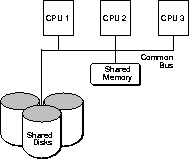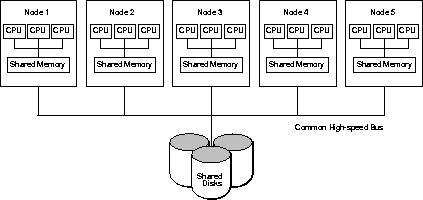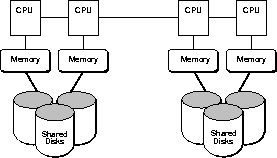Release 8.0
A58238-01
Library |
Product |
Contents |
Index |
| Oracle8 Parallel Server Concepts & Administration Release 8.0 A58238-01 |
|
The parallel database server can use various machine architectures which allow parallel processing. This chapter describes the range of available hardware implementations and surveys their advantages and disadvantages.
This section covers the following topics:
Oracle configurations support parallel processing within a machine, between machines, and between nodes. There is no advantage to running Oracle Parallel Server on a single node and a single system image--you would incur overhead and receive no benefit. With standard Oracle you do not have to do anything special on shared memory configurations to take advantage of some parallel processing capabilities.
Although this manual focuses on Oracle Parallel Server with shared nothing/shared disk architecture, the application design issues discussed in this book may also be relevant to standard Oracle systems.
Parallel processing hardware implementations are often categorized according to the particular resources which are shared. The following categories are described in this chapter:
These implementations can also be described as "tightly coupled" or "loosely coupled," according to the way in which communication between nodes is accomplished.
Attention: Oracle supports all these different implementations of parallel processing, assuming that in a shared nothing system the software enables a node to access a disk from another node. For example, the IBM SP2 features a virtual shared disk: the disk is shared through software.
Note: Support for any given Oracle configuration is platform-dependent; check to confirm that your platform supports the configuration you want.
Online transaction processing (OLTP) applications tend to perform best on symmetric multiprocessors; they perform well con clusters and MPP systems if they can be well partitioned. Decision support (DSS) applications tend to perform well on SMPs, clusters, and massively parallel systems. Choose the implementation that provides the power you need for the application(s) you require.
Each hardware vendor implements parallel processing in its own way, but the following common elements are required for Oracle Parallel Server:
This is a high bandwidth, low latency communication facility between the various nodes for lock manager and cluster manager traffic. The interconnect can be Ethernet, FDDI, or some other proprietary interconnect method. If the primary interconnect fails, a back-up interconnect is usually available. The back-up interconnect will ensure high availability, and prevent a single point of failure.
All nodes in a loosely coupled or massively parallel system have simultaneous access to shared disks. This gives multiple instances of Oracle8 concurrent access to the same database. These shared disk subsystems are most often implemented via a shared SCSI or twintailed SCSI (common in UNIX) connected to a disk farm. On some MPP platforms, such as IBM SP, disks are associated to nodes and a virtual shared disk software layer enables global access to all nodes.
Note: The Integrated Distributed Lock Manager coordinates modifications of data blocks, maintenance of cache consistency, recovery of failed nodes, transaction locks, dictionary locks, and SCN locks.
Tightly coupled shared memory systems, illustrated in Figure 3-1, have the following characteristics:

Symmetric multiprocessor (SMP) machines are often nodes in a cluster. Multiple SMP nodes can be used with Oracle Parallel Server in a tightly coupled system, where memory is shared among the multiple CPUs, and is accessible by all the CPUs through a memory bus. Examples of tightly coupled systems include the Pyramid, Sequent, and Sun SparcServer.
It does not make sense to run Oracle Parallel Server on a single SMP machine, because the system would incur a great deal of unnecessary overhead from IDLM accesses.
Performance is potentially limited in a tightly coupled system by a number of factors. These include various system components such as the memory bandwidth, CPU to CPU communication bandwidth, the memory available on the system, the I/O bandwidth, and the bandwidth of the common bus.
Parallel processing advantages of shared memory systems are these:
A disadvantage of shared memory systems for parallel processing is as follows:
Shared disk systems are typically loosely coupled. Such systems, illustrated in Figure 3-2, have the following characteristics:

The cluster illustrated in Figure 3-2 is composed of multiple tightly coupled nodes. The IDLM is required. Examples of loosely coupled systems are VAXclusters or Sun clusters.
Since the memory is not shared among the nodes, each node has its own data cache. Cache consistency must be maintained across the nodes and a lock manager is needed to maintain the consistency. Additionally, instance locks using the IDLM on the Oracle level must be maintained to ensure that all nodes in the cluster see identical data.
There is additional overhead in maintaining the locks and ensuring that the data caches are consistent. The performance impact is dependent on the hardware and software components, such as the bandwidth of the high-speed bus through which the nodes communicate, and IDLM performance.
Parallel processing advantages of shared disk systems are as follows:
Parallel processing disadvantages of shared disk systems are these:
Shared nothing systems are typically loosely coupled. This section describes:
In shared nothing systems only one CPU is connected to a given disk. If a table or database is located on that disk, access depends entirely on the CPU which owns it. Shared nothing systems can be represented as follows:

Shared nothing systems are concerned with access to disks, not access to memory. Nonetheless, adding more CPUs and disks can improve scaleup. Oracle Parallel Server can access the disks on a shared nothing system as long as the operating system provides transparent disk access, but this access is expensive in terms of latency.
Massively parallel (MPP) systems have the following characteristics:
A massively parallel system may have as many as several thousand nodes. Each node may have its own Oracle instance, with all the standard facilities of an instance. (An Oracle instance comprises the System Global Area and all the background processes.)
An MPP has access to a huge amount of real memory for all database operations (such as sorts or the buffer cache), since each node has its own associated memory. To avoid disk I/O, this advantage will be significant in long running queries and sorts. This is not possible for 32 bit machines which have a 2 GB addressing limit; the total amount of memory on an MPP system may well be over 2 GB. As with loosely coupled systems, cache consistency on MPPs must still be maintained across all nodes in the system. Thus, the overhead for cache management is still present. Examples of massively parallel systems are the nCUBE2 Scalar Supercomputer, the Unisys OPUS, Amdahl, Meiko, and the IBM SP.
Shared nothing systems have advantages and disadvantages for parallel processing:
A combined system can be very advantageous-one which brings together the advantages of shared nothing and shared disk, while overcoming their respective limitations. Such a combined system can be represented as follows:

Here, two shared disk systems are linked to form a system with the same hardware redundancies as a shared nothing system. If one CPU fails, the other CPUs can still access all disks.